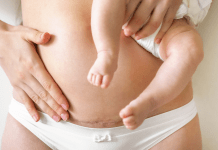 When I was pregnant with my first daughter, I scoured the internet for the best-rated registry items, the perfect “Coming Home” outfit for baby, and the most comprehensive hospital packing list (which even included an eye mask and ear plugs, much to the amusement of my Labor and Delivery nurses).
When I was pregnant with my first daughter, I scoured the internet for the best-rated registry items, the perfect “Coming Home” outfit for baby, and the most comprehensive hospital packing list (which even included an eye mask and ear plugs, much to the amusement of my Labor and Delivery nurses).
However, in all my preparation, I somehow neglected to prepare myself for childbirth recovery. (In my defense, my first daughter was born during the height of COVID, so hospital birthing classes were on pause, and I was happily avoiding any potentially alarming details related to childbirth.)
Unfortunately, ignorance is not always bliss, so my postpartum experience was quite a shock to my system, both physically and mentally. As they say, hindsight is 20/20, so after surviving the experience, I thought I’d share some things I’ve discovered along the way by tapping into expert resources that better prepared me for childbirth recovery in the future.
*Disclaimer: Please consult your personal physician regarding products and your own care for delivery and postpartum.
Tips for Childbirth Recovery
1. Stock up on Basic Supplies
Not all postpartum supplies are created equal. Here are some of the most used items that you’ll want on your bathroom shelves.
Vaginal Delivery:
- Maxi Pads (In those first few weeks post-delivery, the bigger, the better.)
- Large Comfortable Cotton Underwear (Honestly, the bigger, the better here too.)
- Peri Bottle
- Witch Hazel
- Numbing Spray
- Ice Pads
- Stool Softener
C-Section Delivery:
- Maxi Pads (Bonus Use: Attach the adhesive side to your waistband, and you’ll have a little extra cushion between your incision and your clothing that you’ll probably appreciate in those early days.)
- High-Waisted Cotton Underwear
- Abdominal Binder
- Pillow (Keep a pillow nearby to help with compression along your incision when you laugh or cough to help offset some of the pain.)
- Stool Softener
Breast Care:
- Comfortable, Supportive Bra (If you think you might want to breastfeed, I’d recommend a nursing bra and a hands-free pumping bra.)
- Nipple Cream
- Breast Pads
- Cooling Gel Pads, Silverette Cups, etc.
2. Have Realistic Expectations
I reached out to Hillary Sadler (the local founder of Baby Settler, registered nurse, and lactation consultant) for some wisdom related to childbirth recovery. Sadler points out, “After a vaginal birth, many women start feeling better after a few weeks, but may take several months for a full recovery. With a c-section, full recovery often takes six to eight weeks, but internal healing can take several months. I highly recommend working with pelvic floor PT to ensure healing, as well. It’s not just about the perineum or c-section scar.”
3. Prepare for Some Discomfort
Even if you have the best childbirth experience, prepare for at least some level of discomfort over the next few weeks. Depending on your discomfort, you might find relief by using numbing sprays, a sitz bath, Tucks pads, pain relievers, or just sitting on a donut pillow. (Honestly, the donut pillow was the best seat in the house for a solid two weeks, in my opinion.)
4. Know When to Reach Out to a Medical Professional
While you should plan for some discomfort, you should also feel comfortable reaching out to medical professionals when something doesn’t feel right, both physically and mentally. It’s also wise to educate your partner on what to expect, so they can help you see through the newborn fog when it’s time to ask for more help.
- Talk to your OB or medical professional ahead of time about what physical symptoms to expect on your recovery journey and when to be concerned.
- If you choose to breastfeed at all, schedule an appointment with a lactation consultant if you’re having a painful latch or are concerned about your milk supply. As Sadler recommends, “I think every mom (first time or fifth time) highly benefits from a lactation consultant in the first two weeks postpartum. It can make all the difference in your postpartum journey.”
- Lastly, your mental health is a crucial part of your recovery too. If you’re feeling intense sadness, anxiety, or having harmful thoughts, talk to your provider and schedule an appointment with a mental health counselor.
5. Prepare Your Environment
You’ve probably heard all about making freezer meals, cleaning your house, and getting ahead on laundry, but I wish I had thought about creating an actual Postpartum Plan before I was in the thick of it with a new baby at home.
In the linked resource, Sadler helps think through plans for sleeping, eating, exercise, and support systems to have in place at home for those first weeks — so you can better focus on caring for yourself and your new baby. “With your partner, discuss and delegate household responsibilities, set up meal plans or frozen meals, decide on visitor policies, and consider hiring help if possible (a cleaner or doula, for example),” shares Sadler.
6. Lean On Your Village
“Every time I do a prenatal consult, I tell my patients, ‘If there is any way at all that you can lean on your support system and have zero responsibility outside of literally feeding yourself (not preparing food), feeding your baby, and taking care of your personal hygiene during the first two weeks (six weeks is even better), this will set you up best for your postpartum recovery’,” shares Sadler.
Think about the ways your partner, family, and friends can help you. Whether it’s household chores, coordinating a meal train, providing childcare for an older sibling, or just lending a supportive shoulder, now is the time to feel confident asking for help without any guilt.
Hopefully, my time in the throes of postpartum will benefit you as you prepare for a new addition to the family.












